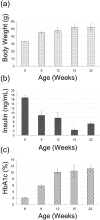Segmentation of the Pathophysiological Stages of Diabetic Changes in the db/db Mouse
- PMID: 22271986
- PMCID: PMC3246058
- DOI: 10.1293/tox.22.133
Segmentation of the Pathophysiological Stages of Diabetic Changes in the db/db Mouse
Abstract
The db/db mouse is one of the diabetes mellitus animal models and if the pathophysiological stages of diabetic changes in the mouse model could simulate the stages in human diabetes, the db/db mouse could be used to better evaluate drug candidates. Blood insulin, HbA1c levels and morphological features of pancreatic islets in db/db mice were evaluated to determine the pathophysiological stage. At 6 weeks of age, db/db mice showed the highest level of plasma insulin and lowest level of HbA1c, and histopathological examination revealed enlarged islets with a circular shape and hypertrophic islet cells. By 9 and 12 weeks of age, the plasma insulin levels had decreased to mid levels and HbA1c had increased to mid to high levels; histopathological examination at this time revealed two types of islets coexisting, enlarged circular islets and small irregular-shaped islets. By 15 and 22 weeks of age, plasma insulin had decreased further to low levels and HbA1c was at its highest level; the histopathological examination at this time revealed an increase in irregular-shaped and small islets. Based on blood insulin levels, HbA1c levels and histopathology findings in the db/db mice in this study, the clinical staging of diabetic changes were recognized. The pathophysiological stages of diabetes mellitus in this animal model were similar to the stages in humans.
Keywords: HbA1c; db/db mouse; diabetes mellitus; histopathology; insulin; pancreas.
Figures



Similar articles
-
Effects of surface camouflaged islet transplantation on pathophysiological progression in a db/db type 2 diabetic mouse model.Biochem Biophys Res Commun. 2013 Apr 19;433(4):513-8. doi: 10.1016/j.bbrc.2013.03.015. Epub 2013 Mar 21. Biochem Biophys Res Commun. 2013. PMID: 23523788
-
Metallothionein 1 negatively regulates glucose-stimulated insulin secretion and is differentially expressed in conditions of beta cell compensation and failure in mice and humans.Diabetologia. 2019 Dec;62(12):2273-2286. doi: 10.1007/s00125-019-05008-3. Epub 2019 Oct 17. Diabetologia. 2019. PMID: 31624901
-
Influence of the mutation "diabetes" on insulin release and islet morphology in mice of different genetic backgrounds.J Cell Biol. 1974 Jul;62(1):77-89. doi: 10.1083/jcb.62.1.77. J Cell Biol. 1974. PMID: 4135113 Free PMC article.
-
Characterization of CS-045, a new oral antidiabetic agent, II. Effects on glycemic control and pancreatic islet structure at a late stage of the diabetic syndrome in C57BL/KsJ-db/db mice.Metabolism. 1991 Nov;40(11):1213-8. doi: 10.1016/0026-0495(91)90218-l. Metabolism. 1991. PMID: 1943750
-
Protective effect of brain-derived neurotrophic factor on pancreatic islets in obese diabetic mice.Metabolism. 2006 Oct;55(10):1286-92. doi: 10.1016/j.metabol.2006.04.017. Metabolism. 2006. PMID: 16979397
Cited by
-
Insulin secretion from beta cells within intact islets: location matters.Clin Exp Pharmacol Physiol. 2015 Apr;42(4):406-14. doi: 10.1111/1440-1681.12368. Clin Exp Pharmacol Physiol. 2015. PMID: 25676261 Free PMC article. Review.
-
Nonproliferative and Proliferative Lesions of the Rat and Mouse Endocrine System.J Toxicol Pathol. 2018;31(3 Suppl):1S-95S. doi: 10.1293/tox.31.1S. Epub 2018 Jul 28. J Toxicol Pathol. 2018. PMID: 30158740 Free PMC article. Review.
-
UCP2 inhibition eliminates pancreatic β cell autoinflammation in T2DM with islet-mitochondrial sequential targeting nanomedicines.Nat Commun. 2025 Jul 24;16(1):6840. doi: 10.1038/s41467-025-61883-y. Nat Commun. 2025. PMID: 40707441 Free PMC article.
-
Mitochondrial dysfunction in the type 2 diabetic heart is associated with alterations in spatially distinct mitochondrial proteomes.Am J Physiol Heart Circ Physiol. 2010 Aug;299(2):H529-40. doi: 10.1152/ajpheart.00267.2010. Epub 2010 Jun 11. Am J Physiol Heart Circ Physiol. 2010. PMID: 20543078 Free PMC article.
-
Targeted Delivery of Butyrate Improves Glucose Homeostasis, Reduces Hepatic Lipid Accumulation and Inflammation in db/db Mice.Int J Mol Sci. 2023 Feb 25;24(5):4533. doi: 10.3390/ijms24054533. Int J Mol Sci. 2023. PMID: 36901964 Free PMC article.
References
-
- Expert Committee on the Diagnosis and Classification of Diabetes Mellitus Report of the expert committee on the diagnosis and classification of diabetes mellitus. Diabetes Care. 26(Suppl 1): S5–S20 2003 - PubMed
-
- American Diabetes Association Diagnosis and classification of diabetes mellitus. Diabetes Care. 27(Suppl 1): S5–S10 2004 - PubMed
-
- Kuzuya T, Nakagawa S, Satoh J, Kanazawa Y, Iwamoto Y, Kobayashi M, Nanjo K, Sasaki A, Seino Y, Ito C, Shima K, Nonaka K, Kadowaki T. Committee of the Japan Diabetes Society on the diagnostic criteria of diabetes mellitus. Report of the Committee on the classification and diagnostic criteria of diabetes mellitus. Diabetes Research and Clinical Practice. 55: 65–85 2002 - PubMed
-
- Alberti KG, Zimmet PZ. Definition, diagnosis and classification of diabetes mellitus and its complications. Part 1: diagnosis and classification of diabetes mellitus. Provisional report of a WHO Consultation. Diabet Med. 15: 539–553 1998 - PubMed
-
- Florence JA, Yeager BF. Treatment of type 2 diabetes mellitus. Am Fam Physician. 59: 2835–2844, 2849–2850 1999 - PubMed
LinkOut - more resources
Full Text Sources
Miscellaneous
